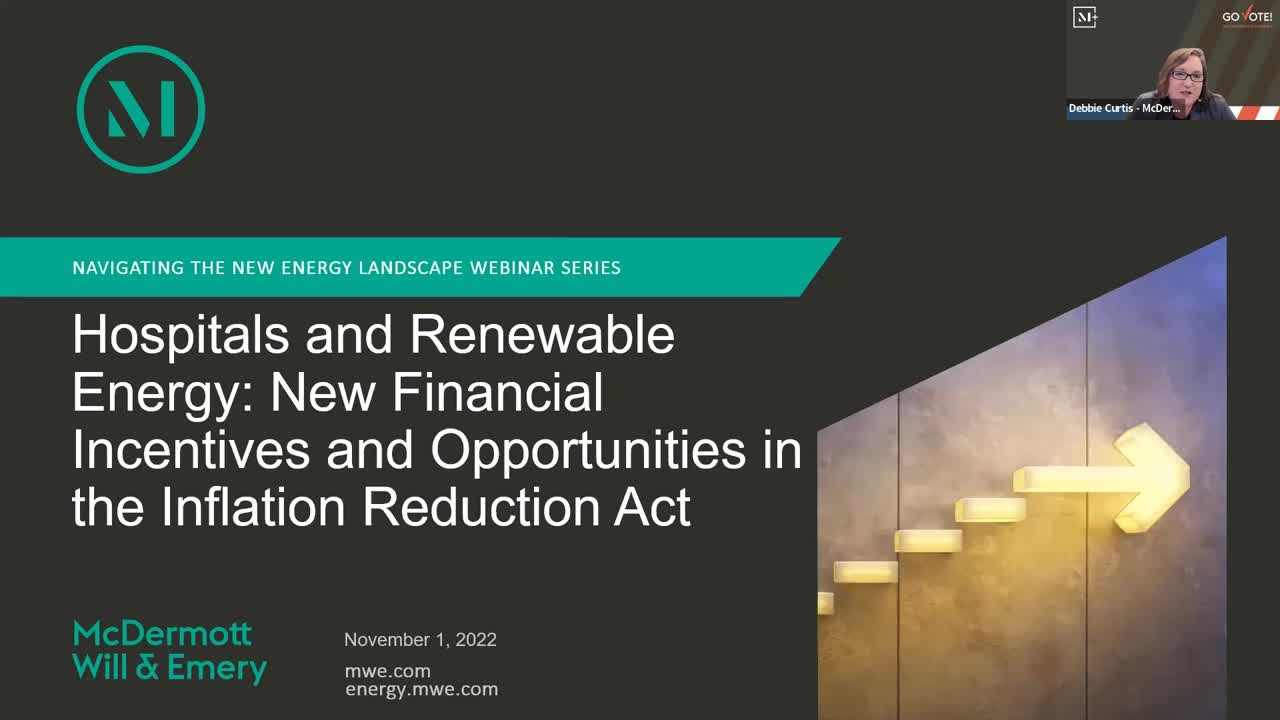During this webinar, Heather Cooper and Carl Fleming, partners in the McDermott’s energy & project finance group, teamed up with McDermott+Consulting’s Debra Curtis to break down the key opportunities and actionable steps that your in-house team stakeholders need to know about to take advantage of what the Inflation Reduction Act of 2022 (IRA) has to offer. Discussion topics included a highlight of important provisions in the IRA and the incentives they hold for hospitals, an update on how the Biden administration is approaching climate change and healthcare, how to track funding sources and apply for tax credits and deductions and more.

Below are key takeaways from the discussion:
1. Hospitals, Healthcare and Climate Change. Hospitals and the healthcare sector both have a role to play in climate change mitigation. The healthcare sector accounts for about 8.5% of all greenhouse gas emissions in the United States and about 4.5% of emissions worldwide. These emissions are generated mostly from running energy-draining facilities 24/7. Hospitals have an opportunity to not only track and report emissions, but also to reduce them.
2. Hospitals and Healthcare Systems Now Face Climate Change Operational Risk. While there may have been a lack of oversight and accountability on hospitals and the healthcare sector in regard to climate change, there are now several forces pushing hospitals—and the healthcare system more broadly—to undertake efforts to reduce their dependence on fossil fuels.
3. Health Sector Climate Pledge. On June 30, 2022, US President Joe Biden announced the “Health Sector Climate Pledge.” As a result, the US Department of Health and Human Services (HHS), in partnership with the White House, is mobilizing the healthcare sector to reduce emissions. Under the Pledge, 61 of the largest US hospital and health sector companies (which account for about 650 hospitals) committed to reducing greenhouse gas emissions by 50% by 2030. Additionally, in response to the Biden administration’s directive to federal agencies on climate change, the HHS has taken several other steps to address the issue. Internally, it has created small offices to examine climate change, health equity and environmental justice.
4. The IRA Is Historic. Perhaps the biggest incentive for hospitals to take action comes from the IRA, which President Biden signed into law back in August. The IRA is the largest climate change legislation ever enacted globally and provides for $369 billion in climate change programs and incentives with a 10-year timeframe (versus the prior one-to-three-year increments). It also greatly expands tax credits for US companies that adopt energy-saving renewable technologies and, for the first time, makes these credits available to nonprofits—a category that includes just over half of the nation’s hospitals.
5. The IRA Unlocks Opportunities for Hospitals. Under the IRA, hospitals now (1) have access to a new significant financial incentive for energy efficiency, (2) gain access to the previously restricted tax equity market via [...]
Continue Reading
read more

 Subscribe
Subscribe
